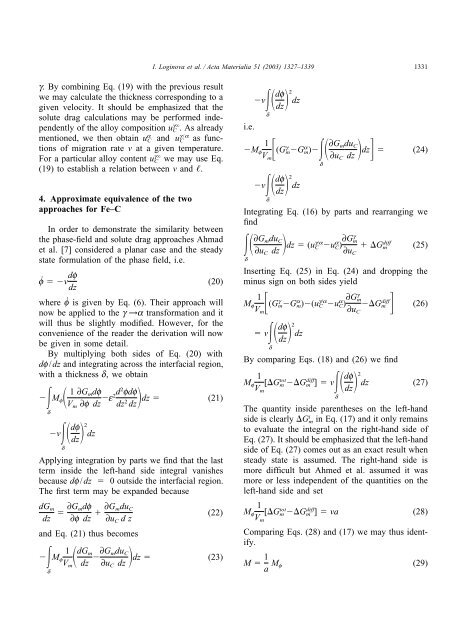Phase-field modeling of diffusion controlled phase ... - KTH Mechanics
Phase-field modeling of diffusion controlled phase ... - KTH Mechanics
Phase-field modeling of diffusion controlled phase ... - KTH Mechanics
Create successful ePaper yourself
Turn your PDF publications into a flip-book with our unique Google optimized e-Paper software.
I. Loginova et al. / Acta Materialia 51 (2003) 1327–13391331g. By combining Eq. (19) with the previous resultwe may calculate the thickness corresponding to agiven velocity. It should be emphasized that thesolute drag calculations may be performed independently<strong>of</strong> the alloy composition uC g . As alreadymentioned, we then obtain u a C and uCg/a as functions<strong>of</strong> migration rate v at a given temperature.For a particular alloy content u gC we may use Eq.(19) to establish a relation between v and .4. Approximate equivalence <strong>of</strong> the twoapproaches for Fe–CIn order to demonstrate the similarity betweenthe <strong>phase</strong>-<strong>field</strong> and solute drag approaches Ahmadet al. [7] considered a planar case and the steadystate formulation <strong>of</strong> the <strong>phase</strong> <strong>field</strong>, i.e.ḟ v df(20)dzwhere ḟ is given by Eq. (6). Their approach willnow be applied to the g →a transformation and itwill thus be slightly modified. However, for theconvenience <strong>of</strong> the reader the derivation will nowbe given in some detail.By multiplying both sides <strong>of</strong> Eq. (20) withdf/dz and integrating across the interfacial region,with a thickness d, we obtainM df 1∂G m df fdfV m ∂f dz e2d2 (21)dz dzdz 2v df 2dzdzdApplying integration by parts we find that the lastterm inside the left-hand side integral vanishesbecause df/dz 0 outside the interfacial region.The first term may be expanded becausedG mdz ∂G mdf∂f dz ∂G mdu C(22)∂u C dzand Eq. (21) thus becomes1M fVdm dG mdz ∂G mdu C∂u C dzdz (23)v df 2dzdzdi.e.1M fV m(G g mGm) ∂G a mdu C∂u C dzdz (24)dv df 2dzdzddIntegrating Eq. (16) by parts and rearranging wefind ∂G mdu C∂u C dzdz (u g/aC u a C) ∂Gg mG∂u diffm (25)CInserting Eq. (25) in Eq. (24) and dropping theminus sign on both sides yieldm (26)1M fVmGm(G g a m)(uC g/a u a C) ∂Gg m df dz vd2dz∂u CG diffBy comparing Eqs. (18) and (26) we find1M f [GV totm G diffm df 2dz (27)dzm ] vdThe quantity inside parentheses on the left-handside is clearly G i m in Eq. (17) and it only remainsto evaluate the integral on the right-hand side <strong>of</strong>Eq. (27). It should be emphasized that the left-handside <strong>of</strong> Eq. (27) comes out as an exact result whensteady state is assumed. The right-hand side ismore difficult but Ahmed et al. assumed it wasmore or less independent <strong>of</strong> the quantities on theleft-hand side and set1M f [GV totm G diffm ] va (28)mComparing Eqs. (28) and (17) we may thus identify.M 1 a M f (29)
















